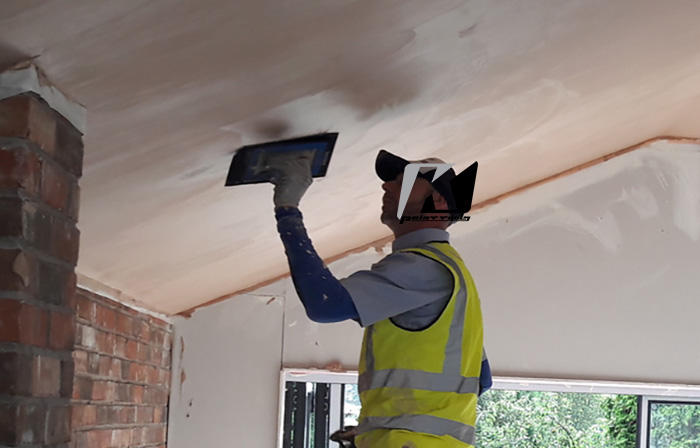
Over the last few years, there’s been a stark increase in the use of plastic trowels within the global construction industry.
Not-only that, there is now a clear division between tradesmen as to which is the better tool for the job – plastic or metal?
With such a huge range of choice now available both online and in store, and amazon...etc. The plastering world has seen significant leaps forward recently in terms of the technology available and the tools used on site day-to-day.
For example, a trowel that gave a great finish 5 or 6 years ago has now probably been surpassed by a more modern and lightweight version.
For a lot of plasterers, the choice between a plastic or a metal trowel is quite clear. You’ll either love the new plastic varieties or loathe them! Let’s take a look at each version in turn, and then we’ll deliver our opinion on which trowel reigns supreme.
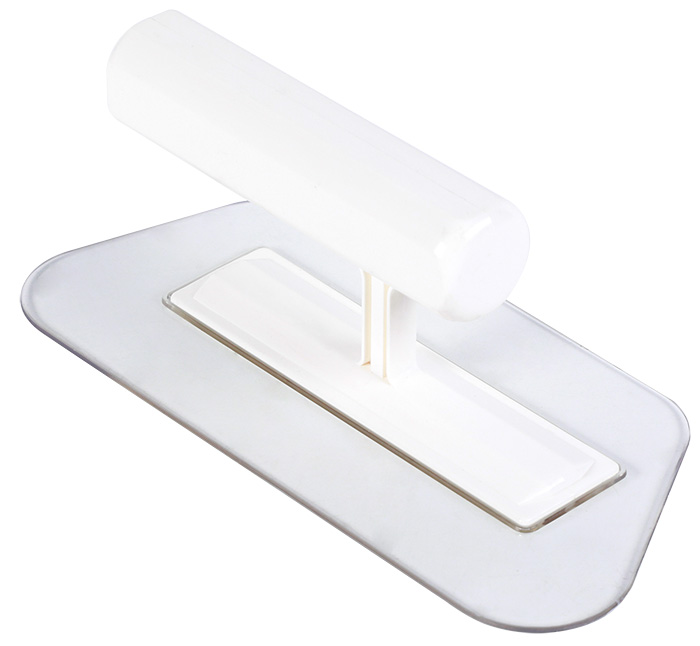
K Brand Plastic Trowel SB-PT-H
The more traditional plastering trowel is usually made from stainless steel and is therefore built to last. They will usually require a little more maintenance but if looked after can last for years at a time.
By default, any type of metal trowel will be stronger than a plastic one and is therefore much less susceptible to damage when being used on site.
Despite their strength and reliability, metal trowels are generally heavier than their plastic counterparts and this can have an impact on your ability to plaster a wall effectively the longer a job goes on. For example, plastering for 3 hours with a metal trowel will be far more strenuous than using a plastic trowel.
Metal trowels can be relied upon to bring consistency to your plastering as they have done for decades, but the rise in popularity of plastic trowels has given that alternative option for plasterers looking to take their work to the next level.
Don’t forget about K brand Spatulas (Drywall Skimming blades Spat Smoothing Tool Ideal for painting and Walls tools) that can be relied on to deliver a high-quality finish consistently – this is why the spatulas are the number one choice for many plastering professionals at the moment.
The spatula-feature advanced engineering and the high-quality #304 stainless steel for superior strength and durability. The secret is the strong but flexible stainless-steel blade and the precise fulcrum point designed into the hand grip area.
This allows the blade to have up to more contact area with the surface, generating a superior finish,which is used to achieve a professional finish when smoothing and finishing wall-coated drywall compound.
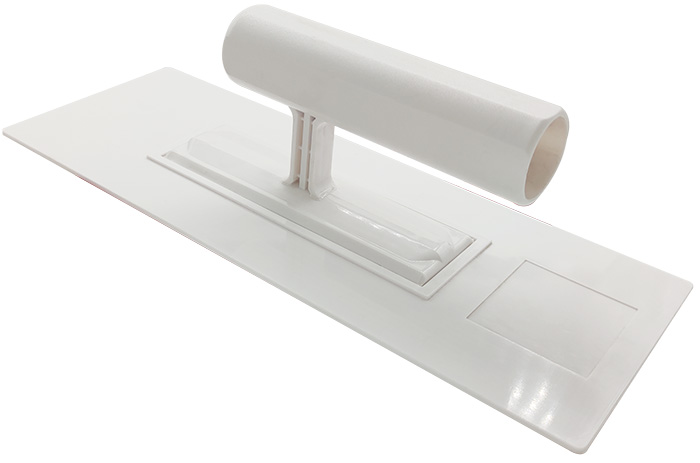
About Plastic Trowels
The new kid on the block is the plastic trowel. Lighter and more flexible, plastic trowels are ideal for those in need of a tool that is easier on their body when plastering.
Most plasterers that have recently made the switch to plastic trowels have done so due to their lighter weight. Less weight means less effort is required to plaster a wall – and let’s be honest, who doesn’t want that?
There is now a huge range of plastic trowels available on the market to suit almost any need, so if you’re looking to try one out, now is the time.
Plastic tools aren’t without their downsides however. As they aren’t made from such a sturdy material, they are more susceptible to damage during use, especially when going over beads for example.
It’s fair to say that the plastic trowel shouldn’t be viewed as a complete replacement for your metal trowel just yet – they’ve been specifically designed and developed to help with the finishing of a wall or ceiling.
What we will say is that it’s certainly worth trying out a plastic trowel to see if it suits your plastering style, as it will invariably make your life easier if so.
The majority of plasterers don’t like to change their kit too regularly, especially when they’ve found a specific tool that they’ve used for a while and are really comfortable with – but this is definitely one area you might want to experiment.
Plastic trowels have caused a stir in the plastering world in recent years, but what’s all the hype about? We’ve seen a complete split of opinion in the trade when it comes to the great trowel debate.
The construction industry has seen rapid changes in the last few years, especially in the tools arena. The new technology and new tools available can rapidly speed up a job and make life a lot easier. However, a lot of plasterers believe in the traditional tools they used when learning the trade and don’t see the benefits of bringing in something new.
A plaster trowel is a trowel that has been used to spread a smoother plaster over the walls. Usually, plastic plastering trowels are used for finishing topcoat renders and for internal decorations.
Whether you are a professional for many years in plastering or a newcomer, it is important to have a plastering trowel in your toolkit to start your job. If you are starting off, then the first question that pops up is what size of trowel they should buy.
So, you should buy a small size of plastic plastering trowel if you are a beginner to have good control over your plastering job. If you know the technique of plastering and if you have good control, then you can choose a big size of plastering trowel as well.
When if you want a plastering trowel that offers a great finish and that stands the test of the time, then choosing a trowel from one of the good brands (K brand) is a good option. Plastic plastering trowels are the most famous trowels because of their durability, light in weight, and versatility.
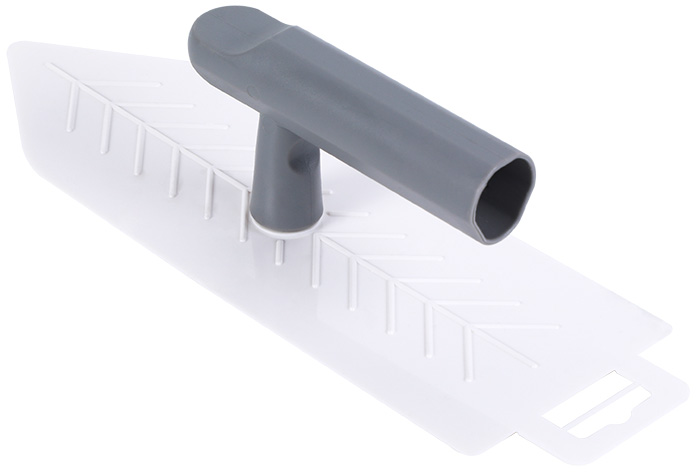
K Brand Plastic Trowel SB-PT-B
The Advantages of Plastic Trowels
Plastic plastering trowels are cleaner, providing a better finish as well as these are far easier on joints of the worker. Because they are light in weight; therefore, a person can perform a task for a longer time. They are also light in weight, therefore easier to carry.
However, you must note that plastic plastering trowels tend to damage soon when compared to the metal trowels, but other a lot of advantages of plastic trowels make them a great option for people.
Light in weight:
Plastic plastering trowels are light in weight, thus making it easier to do the job with these trowels. Less weight means you have to put less effort into doing the job. Therefore, all can be said that one can get better finishing over the walls while putting less effort with the help of these trowels.
Flexible:
Plastic trowels are more flexible than that of other trowels present in the market offering you better control over the work and design. Therefore, it allows you to get the same design as you want with better finishing.
The design and the main purpose of the flexible trowels are that they can provide a better finish to the walls without causing stress and joint pain to your body. These move easier making you get the design that stands out the others.
For the final stages of the plastering, choosing a flexible trowel is great because it provides a better finish and makes the entire task a lot easier and smoother.
Easy on body:
Most of the professionals want a trowel that is easy for their body. When you have to work continuously for hours, then you know that even one gram of weight plays a crucial role. Plastic trowels tend to be lighter in weight, therefore it does not cause pain to the joint while other metal trowels are heavier than plastic trowels making you feel pain in joints after the continuous working of a few hours.
Versatile:
Plastic trowels are highly versatile, and you can use these in various stages of plastering and for many other applications as well. You can flatten as well as give finishing to the walls with these trowels.
Plastic plastering trowel has brought a revolution in the plastering industry with its flexibility and light in weight features. They make the work of a plastering professional easier, and a good quality plastic plastering trowels is going to add a good finish to your work.
Great trowel debate
We wanted to find out where you stood in the great plastic vs steel debate so reached out and asked on Facebook and Twitter...etc.
We were specifically interested in hearing your thoughts on the advantages and disadvantages of plastic trowels and how often they’re used. There was a definite split with plasterers who prefer steel, like Alex Wang, “I always use my steel trowel from start to finish.
No bumps, no ripples and still get the shine that I want.” While on the other side of the fence were plasterers such as Peter, who have tried plastic and become advocates; “I find plastic trowels a lot easier. It takes a few months to perfect but it’s worth it in the end. Now, I’d hate to do a set all the way through with a steel trowel.”
While we did see strong arguments supporting both sides of the debate, it was clear that some of the comments highlighting a bad experience using a plastic trowel stemmed from misinformation about the product.
Plastic trowels are designed exclusively for finishing and aren’t an out-and-out replacement for steel, rather an addition to the toolbox. Despite all the advances and new designs, stainless steel trowels remain the best tool for installing the first few coats of plaster.
And before you think that’s a win for steel, we saw disagreement over how effective stainless-steel trowels are for finishing. Mr. Townsend commented, “I get better finishing results with plastic. There’s also a lot less wear on my bones once you’ve mastered your style.” Plastic trowels are more flexible than stainless steel models, helping to create neat finishes with a touch of shine.
Another advantage of plastic trowels, in most cases, is that they’re much lighter than stainless steel alternatives, which means walls can be finished with less effort.
Jake Hardy agrees, “I use a steel trowel to lay on both-coats and then to flatten it off. After that, I move onto plastic for the final three to four trowels. I like plastic trowels because they are lot cleaner, give a more even finish and are far easier on my joints.”
It was clear from the responses that there are many preferred methods for finishing a wall and drawbacks to using plastic, such as their material weakness when compared with steel. Ben Birkett has experienced this when using a plastic trowel and said, “Plastic trowels get too many nicks and bumps, so I use a stainless-steel flexible blade to finish.”
Over-all it was a mixed bag, and while stainless steel will always be the preferred choice for some, we had a large amount-of-responses from plasterers who will also use plastic.
Take Seth Adams, for example, who says, “You cannot plaster properly from start to finish with a plastic trowel. Should only really be used for a final ‘Shine’”. Similarly, Carl Sowerby says, “Both! Put on with stainless steel then polish off with plastic.”
K Brand Plastic Trowels Review:
After receiving the following set of plastic trowels courtesy of "G.SB Paint Tools", here is a review of Peter from USA:
Had my first chance to give the trowels a whirl, I had a small job on the go bedroom re- skim heavy ceiling had to be bonded out sealed with stabilizer the same day and paved the next day before skimming, the walls had some making good but a basic 2 coat paved was the order of the day.
I looked at the trowels and slid the medium sized cushioned plastic sleeve onto the trowel, it needs a bit of a push to clip it in but a bit of WD-40 would help me in the future.
K brand plastic trowel feels comfortable in your hand and the plastic handle feels ok but there is a little ridge that you can feel under your index finger but it is no big deal, I felt the blades of the plastic sleeve and decided to sand them down a bit and sand off the toe corners to round them off a bit as well.
To the plastering stage ceiling first, for now I went for laying it on with a steel trowel as normal, and waited for it to pick up after ten minutes or so, picked up the plastic trowel and started to flatten.
Well, the first thing you notice is there is no resistance from the plaster and you have to look twice to see if the trowel is working... But it is and it works great and even saves a bit of time I feel, decided after another ten minutes to flatten it again and now the ceiling is super flat and I am quite impressed at this stage. Knocked up for second coat and lay it on with the steel trowel washed up and waited.
After two flattening in trowels and two cross trowels one wet and one dry with the plastic trowel the ceiling was finished and looked great: better than i normally do with a steel trowel .......
Yeah, hands up it was and in well impressed, done a couple off walls with the same result and now waiting till after Christmas to see how it dry out.
Overall, I think the trowels are great don't think they will replace steel but I will be using one from now on. On the upside, the trowels are easy to use, make lighter work of troweling up skimming due to less pressure you have to put on the trowel, leave a good flat even finish to walls and ceilings.
On the down side, you need to have some fine sand paper to hand as the plastic nicks easy, not sure how long they last you. Overall, I think the trowels are well worth ago, everyone is different but they suit me, and I should be telling you all this no, should keep it to myself: Well-done G.SB Paint Tools and thanks very much.
Spoke to my friend and he said I noticed someone saying that they weren't so good in corners because of their flexibility, maybe they were using the cushioned type instead of the plain version which is much stiffer and therefore better in that situation.
The stainless-steel trowel is also meant to be used independently when necessary. Generally, the plain trowels are best for first and second coating and the cushioned type for flattening and also contouring surfaces such as swooped ceilings.
That is all a matter of using the best version for the job and not be constrained by only having a single steel trowel as in the past. As spreads get used to K brand plastic trowels, we find that they start to use their steel trowels less and less.
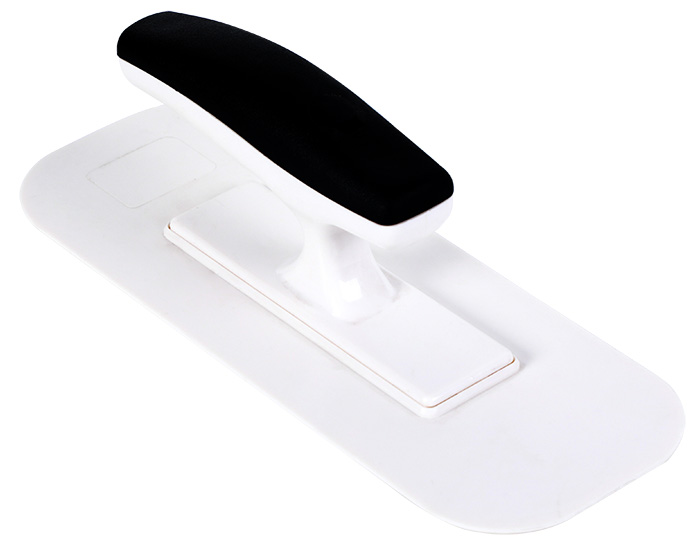
K Brand Plastic Trowel SB-PT-E
Plastic Trowels Taking the Construction Industry by Storm
Plasterers are always on the lookout for new products that can speed up the process or make their job a little easier or at least give your arms a little break. The following is a short story about a plasterer named Peter from the UK and the plastic plastering trowel:
The Plastic trowel is very flexible, and the foam backed one is only really for flattening off and for finishing and to be honest many plasterers love K brand plaster tools for putting on, and they find it comfy for laying on neatly and at a decent pace.
Previous: None.
Next: China bathroom ceramics
Copyright:@2020-2021
Comments Please sign in or sign up to post.
0
0 of 500 characters used